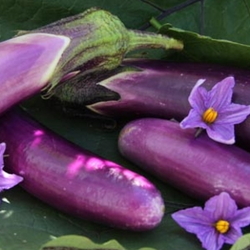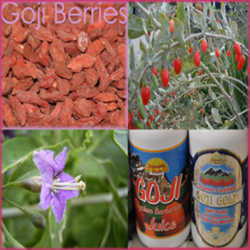Tomatoes, peppers, potatoes, and eggplants form the backbone of many backyard gardens. These seemingly diverse crops are all members of a single plant family, the nightshades (Solanaceae). Study the flowers and fruits of nightshades, and you'll find identical structures. This relationship is a clue that these crops benefit from somewhat similar cultural conditions, and succumb to many of the same pests and diseases.
Here's a plateful from "week 11" at Clagett Farm CSA. Four of the eight items are from the nightshade family.
The nightshades are among the easiest vegetables to put in the ground. Tomatoes, peppers, and eggplants are always found in late spring as little starter plants at nurseries. What gardener can resist those baby plants, when visions of vine ripe, homegrown vegetables dance in his or her head? These three are simple to grow from seed as well. Tomato, pepper, and eggplant seeds germinate faithfully and grow quickly. Their cousin, the potato, is not grown from seed, but planted in spring as purchased, cut up,"seed potatos". All of these crops need full sun and grow best on a rich, nearly neutral soil. They should be watered regularly during the season to keep them growing vigorously. Add mulch once the soil is warm and the weather is balmy.
Hot or cold?
A temperature preference separates the potato from its three cousins here. Potatoes need a cooler soil, hence their association with Idaho and Maine, and not, say, Florida and Texas. On the other hand, tomatoes, peppers and eggplants must only be planted when the soil is warm, and enjoy hot weather for the most part. Seeds sprout more quickly when warm, and a raised garden bed provides warmer soil. Eggplants are the most heatloving of this bunch. Peppers and tomatoes can suffer when temps top 90 degrees F.
Despite starting as tiny seeds, or pieces of tuber, these plants are fast growing and need roomy accomodations. Potatoes must be hilled; that is, dirt or straw is mounded around the stems as they grow. The tubers will form in the mound. Tomatoes of all kinds do best with cages or support, and make it a tall sturdy support for "indeterminate" types. Peppers and eggplants become a small bush, so space them about two feet apart as you would for tomatoes.
For many gardeners these plants go gangbusters, and for many they simply go bust. These can be some of the more disease prone, finicky crops in the garden. They are all subject to various wilts, rots, and blights. You might improve your odds with tomatoes by only planting disease resistant hybrids. They have the capital V, F, N, and T, or some combination thereof, after their name. More importantly, change the location of your nightshade vegetables every year. Give the plants good general care. Water only at the soil surface, keeping the leaves dry.
Bugs can bug the nightshades quite a bit. There are the "trademark" pests (Colorado potato beetle, tomato hornworm) and plenty of general garden pests (flea beetles, aphids and others) which find most nightshades as delectable as we do. Peppers being, well, peppery, are fairly free from insects. Check tomatoes, peppers, and eggplants often. Handpick big bugs, and try natural soaps on the those smaller and more numerous.
More fun with nightshades
Goji, or wolfberry, is a nightshade. And that's all I have to say about goji, because Diana Wind, RD describes goji in an interesting article, "Superfruit - Goji Berry, Lycium babarum."
The nightshade (Solanaceae) family of plants contains some of the most useful crops in the world, the loveliest flowers, and also some of the most deadly plants. It's really no surprise that tomatoes were once thought to be toxic. This same family includes deadly nightshade (Atropa belladonna), devil's trumpet (Datura) and tobacco (Nicotiana.) The neurotoxins in the poisonous Solanaceae are refined into medically useful compounds such as stimulants, sedatives, antinausea drugs, and opthalmic drops for pupil dilation. Mankind has undoubtedly both greatly benefitted, and suffered, from wide cultivation of various nightshades.
Solanine is a nightshade toxin, associated with green skin on potato tubers. According to Harriet A. Hall, MD, writing at Science Based Medicine, it's virtually impossible to eat enough solanine from potatoes to cause illness. Solanine is bitter, so for palatability, always peel green skin and remove eyes from potatoes before eating them. Also don't eat any tiny fruits that may form on potato plants.
Datura and Brugmansia may be the most beautiful of the non-food nightshades. These tropical flowering bushes produce gorgeous, intensely fragrant, trumpet shaped flowers. Having grown both Datura and Brugmansia, I urge other gardeners to give them a try. Their special needs are worth the extra care, at least once.
Tomatillos, cape gooseberries, and edible ground cherries are all found in the Physalis genus of nightshades.
~@~ ~@~ ~@~ ~@~ ~@~
Photo courtesy of Steven Walling, in Wikimedia, licensed under the Creative Commons Attribution 2.0 Generic license
















